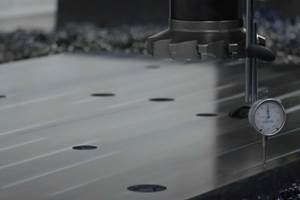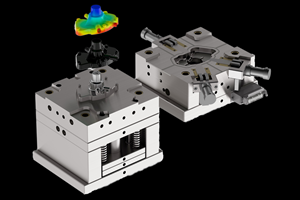Ballscrew Inspection Considerations
Ballscrews must be inspected for diameter, pitch, lead angle and potential drunkenness to avoid wear and to achieve the necessary tolerances and surface finishes in mold work.
Ballscrews in a machining center are not likely on a moldmaker’s checklist. However, since ballscrews are akin to a car’s transmission, they should make the list. They drive the linear axes of any machine tool and hopefully in the desired direction. Ballscrews play an important role in machine tool design for mold manufacturing, as they help deliver the high-cutting load forces necessary for roughing and for achieving the superior surface finishes and tight tolerances molds require today.
For example, mold-base manufacturing demands a heavy-duty machining center with comparably large, accurate ballscrews of at least 3 inches to exert the tremendous forces and cutting loads associated with removing large amounts of material. The linear axes need significant thrust capability to drive those axes through the cut and do so in a stable, consistent manner to avoid backlash and chatter, which can lead to
premature cutting tool failure.
Moldmakers who are producing smaller cavity and insert-type molds with intricate details requiring tight tolerances and superior surface finishes demand significantly higher feedrates and more rapid axial reversals during machining. Ballscrews play an important role here. The rapid reversals are often dynamic, and the ballscrew and corresponding nut need to respond accordingly. A specially designed ballscrew and mating nut can better deliver that rapid reversal of any given axis.
When considering a machine tool for moldmaking, consider the roughing and finishing requirements for the application at hand. Ask the supplier to peel back the cover of the machine to see the “transmission.” Examine the design, pitch and diameter of the ballscrew. Depending on the application, two ballscrews and two servo motors are optimal on an axis to deliver the thrust requirement and the proper dampening for that particular axis. It also is important to verify ballscrew size. Ensure that they are not undersized or oversized based on what the machine will be doing and the load it will be carrying. Also consider whether the ballscrews will be able to accelerate, decelerate and change direction instantaneously.
If a ballscrew is not manufactured to a very high standard and put through several rigorous quality checks, an axis may be moving in an undesirable fashion. The ballscrew itself may have an accuracy and repeatability problem, or the load force exerted on that axis may not be evenly distributed. So, instead of pushing that axis in a straight and concentric fashion, the ballscrew attempts to move at an angle. This causes undue stress and premature wear on the ballscrew. Also, if there is an excessive amount of runout in the ballscrew, or if the threads of the ballscrew are not machined in, hardened and ground concentric to the cylindricity of the ballscrew shaft itself, then the component experiences “ballscrew drunkenness,” which reflects the difference between the theoretical ball path and the actual ball path. The actual and the theoretical paths need to be as close together as possible, as any deviation will cause wear, which degrades the machine’s positional characteristics over time.
Ballscrew drunkenness can lead to several negative outcomes, including machine tool inaccuracy, premature ballscrew, mating nut or guiderail wear (whether it is a box guideway or a linear guiderail). Therefore, some machine tool builders ensure that the ballscrews used in their machines are put through several arduous quality checks and are manufactured to an exacting standard, such as the use of a special machine to check ballscrew drunkenness. This tool ensures that the thread of the ballscrew is machined in a very concentric fashion to the major diameter of the ballscrew itself. This puts the ballscrew pitch and lead exactly where they should be and makes the thread equal and concentric all the way around the ballscrew.
It is important to ensure that the thread of the ballscrew is machined in a very concentric fashion to the major diameter of the ballscrew itself.
About the Contributor
Robb Hudson
Rob Hudson is CEO of Mitsui Seiki USA, Inc.
Related Content
How to Produce More Accurate Molds and Reduce Rework
Patented micro-milling process for manufacturing steel plate flat and parallel helps mold builders shorten mold build times and increase accuracy.
Read MoreTips for Tackling Mold Design, Machining, Cutting Tool and Wear Challenges
Tips for tasks ranging from reducing risk in part design and taking advantage of five-axis machining to refining cutting tool performance and reducing wear with guiding and centering systems.
Read MoreDevelopments in High-Speed Machining Technology
There have been many exciting developments in high-speed machining relative to machining centers and controls, tooling and CAD/CAM systems.
Read MoreHow to Eliminate Chatter
Here are techniques commonly used to combat chatter and guidelines to establish a foundation for optimizing the moldmaking process.
Read MoreRead Next
Reasons to Use Fiber Lasers for Mold Cleaning
Fiber lasers offer a simplicity, speed, control and portability, minimizing mold cleaning risks.
Read MoreAre You a Moldmaker Considering 3D Printing? Consider the 3D Printing Workshop at NPE2024
Presentations will cover 3D printing for mold tooling, material innovation, product development, bridge production and full-scale, high-volume additive manufacturing.
Read MoreHow to Use Strategic Planning Tools, Data to Manage the Human Side of Business
Q&A with Marion Wells, MMT EAB member and founder of Human Asset Management.
Read More







_300x250 3.png;maxWidth=300;quality=90)

.jpg;maxWidth=300;quality=90)




.png;maxWidth=300;quality=90)










